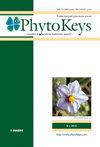Atlas Florae Europaeae notes, 33.Cytisusratisbonensis属(豆科)东欧种的分类概要。
摘要
根据形态学以及标本馆标本和观察结果的综合处理,对东欧的一组具有严格侧生花序的Cytisussect.Tubocytisus(通常称为C.ratisbonensis s.l.)物种进行了严格的修订。共确认了 7 个种和 2 个假定的杂交种。每个物种都有完整的描述,包括异名、类型、简要形态描述、生态和分布数据、分类和命名注释。Cytisuspolonicus 被描述为科学界的新物种,根据形态和二倍体(相对于四倍体)染色体数目与 C.ratisbonensis 区分开来。C.elongatus 的标本型被取代,并指定了一个新的标本型;该名称优先于之前称为 C.triflorus 的物种。6 个种名被列入新的异名:Chamaecytisuspineticola 归入 Cytisusruthenicus s. str.,Cytisusczerniaevii、C.leucotrichus、C.lindemannii、C.ponomarjovii 和 Chamaecytisuskorabensis 归入 Cytisuselongatus。C.ruthenicus 和 C.elongatus 之间的假定杂交种被错误地称为 C.czerniaevii,在此描述为 C.semerenkoanus。Cytisuslithuanicus自最初发表以来一直是一个晦涩难懂的名字,现在这个新近被承认的八倍体物种又复活了,它是波兰东部、白俄罗斯西部和乌克兰西北部的特有种。C.cinereus 这一名称重新用于以前被称为 C.paczoskii 的物种,C.horniflorus 被添加到其同义词中;其完整的分布区被圈定,其在奥地利、波兰、罗马尼亚、塞尔维亚和斯洛伐克的出现也被记录在案。白俄罗斯首次报告了 Cytisuskreczetoviczii 和 C.elongatus,波斯尼亚和黑塞哥维那、黑山和斯洛文尼亚也报告了后者。据报道,Cytisusborysthenicus 和 C.elongatus 是欧洲俄罗斯一些地区的新物种。Cytisusratisbonensis s.str.在东欧被视为不存在。发现了被忽视的 C.ruthenicus 的原始标本,并对所有其他名称的命名法进行了核实,必要时进行了更正。重新发现了 C.borysthenicus 的原始材料。另外还指定了 5 个标准模式和 1 个新模式。根据大量标本馆藏品和观察记录,并经作者鉴定或验证,划定了分布区域。白俄罗斯、乌克兰和俄罗斯的无名分类群的染色体计数是根据标本馆凭证分配给该物种的:C.borysthenicus、C.kreczetoviczii 和 C.lithuanicus 为八倍体(2n = 100),C.ruthenicus 为四倍体(2n = 50)和八倍体(2n = 100),C.semerenkoanus 和 C.elongatus 为四倍体(2n = 50)。A group of species of Cytisussect.Tubocytisus with strictly lateral inflorescences, commonly referred to as C.ratisbonensis s.l., is critically revised in Eastern Europe on the basis of morphology and comprehensive treatment of herbarium specimens and observations. Seven species and two presumed hybrids are recognised. Complete accounts are provided for each species, with synonyms, typifications, brief morphological descriptions, data on ecology and distributions, taxonomic and nomenclatural annotations. Cytisuspolonicus is described as new to science, separated from C.ratisbonensis on the basis of morphology and diploid (vs. tetraploid) chromosome count. The lectotype of C.elongatus is superseded and a new lectotype is designated; this name has priority for the species previously known as C.triflorus. Six species names are newly placed to the synonymy: Chamaecytisuspineticola under Cytisusruthenicus s. str., and Cytisusczerniaevii, C.leucotrichus, C.lindemannii, C.ponomarjovii and Chamaecytisuskorabensis under Cytisuselongatus. The presumed hybrid between C.ruthenicus and C.elongatus, which was incorrectly known as C.czerniaevii, is described here as C.semerenkoanus. Cytisuslithuanicus, which has been an obscure name since its original publication, is resurrected for a newly-recognised octoploid species, which is endemic to eastern Poland, western Belarus and north-western Ukraine. The name C.cinereus is re-instated for the species previously known as C.paczoskii, and C.horniflorus is added to its synonymy; its complete distribution area is circumscribed, and its occurrence in Austria, Poland, Romania, Serbia and Slovakia is documented. Cytisuskreczetoviczii and C.elongatus are reported for the first time from Belarus, and the latter species also from Bosnia and Herzegovina, Montenegro and Slovenia. Cytisusborysthenicus and C.elongatus are reported as new to some territories in European Russia. Cytisusratisbonensis s. str. is treated as absent from Eastern Europe. The neglected protologue of C.ruthenicus is discovered, and the nomenclature of all other names is verified and corrected when necessary. The original material of C.borysthenicus is re-discovered. Five further lectotypes and one neotype are designated. Distribution areas are circumscribed on the basis of numerous herbarium collections and documented observations, identified or verified by the authors. Chromosome counts published for nameless taxa from Belarus, Ukraine and Russia are assigned to the species according to their herbarium vouchers: C.borysthenicus, C.kreczetoviczii and C.lithuanicus are octoploid (2n = 100), C.ruthenicus is tetraploid (2n = 50) and octoploid (2n = 100), and C.semerenkoanus and C.elongatus are tetraploid (2n = 50).

 求助内容:
求助内容: 应助结果提醒方式:
应助结果提醒方式:


